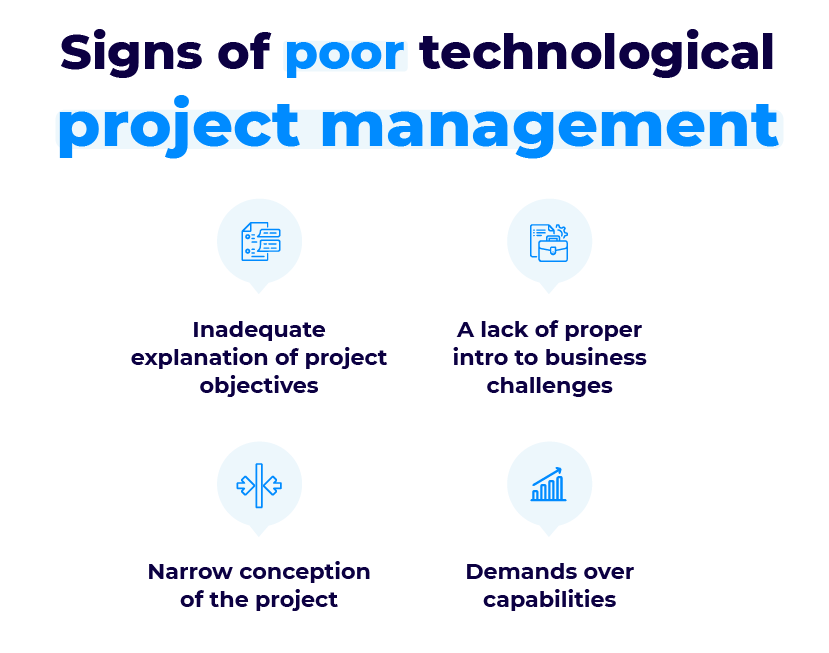Welcome to WordPress. This is your first post. Edit or delete it, then start writing!

How to verify if the project progress is going in the right direction?
Software
,Technology
,Tools
Suppose you have already started cooperation with a software company and want to track project progress. Despite extensive knowledge of development procedures, you encounter serious problems with measuring project progress, and assessing whether your project is heading in the right direction.
In the previous articles from this series, we discussed how to prepare for mobile development using a gambling app as an example and provided tips on reducing the costs of such a project. Now, we continue the topic of mobile development, but this time we approach the issue from a slightly different perspective.
We are here to assist you in identifying all of the red flags and poor practices that prevent you from delivering an excellent product. By reading our article, you will discover how a perfect collaboration and performance measurement should function, and if yours falls short, figure out how to improve it.
Measure project progress to create an ideal cooperation
Product development is a complex and sophisticated process that differs from one software company to the other. Some project teams adopt flexible Agile development that favors cross-functionality and the interplay of particular tasks. Others choose to develop according to the Waterfall approach, following a pre-defined framework and project timeline in which parts of a project are handled sequentially.
But regardless of the method, your software development partner should meet certain criteria that need to be completed to allow you to release an outstanding mobile application before the predetermined deadline and within budget. Let’s look into various aspects of project tracking to establish how an ideal collaboration between the Project Manager and the development team should look and what practices you have to avoid at all costs.
Project management and cooperation between teams
In a perfect mobile software development world, project management, and the cooperation between the backend and mobile teams is smooth and continual. They plan each feature together, providing detailed schemas and preparing APIs. You can immediately tell that both teams get along well and challenge each other in pursuit of making a successful project.
It is a worrying sign, however, when the teams work independently and reach out only when something falls through. Additionally, if you discern that any suggestion of change is treated as a hostile attack, it is a huge red flag. At the end of the day, every team member should be looking in the same direction and striving for the best overall project results.
Defining requirements and setting tasks
While discussing new features and project plans, the team asks questions, raises warnings, and examines security issues to find edge cases ahead of development and plan how to avoid them. In the event of a technical problem, they propose workarounds to resolve it and ensure that the software runs properly. The development team can assess your vision from both technical and business perspectives, challenging you to rethink your ideas. Can you relate? If so, you can sleep peacefully because the progress of your project is doing just fine.
The problem arises when developers take requirements as they are without verifying them. If you rarely hear questions about the app’s functionality, you should be concerned, as this may indicate a lack of commitment and only a superficial understanding of project requirements. Needless to say, it can increase the number of bugs and errors that occur along the way, causing the app’s deployment to be delayed.
Business understanding
The key to success is making sure that everyone understands not only the project’s goal but also its business value. In optimum conditions, the Project Manager, and team members have a good grasp of the company’s vision so they feel at ease during meetings with business departments and bring innovative ideas to the table.
In the worst-case scenario, developers reject to participate in any business-related discussions and refuse to adapt the technical components to industry requirements. Any request for a temporary decrease in tech quality, for instance, to meet the deadline, ends up with a tech riot making things even worse. Such an atmosphere is not conducive to the product’s development.
UI/UX development
The UI is an essential element of every application. A well-executed interface is a competitive edge because it enables you to convert temporary visitors into regular users. While designing the visual layer of your app, you should get a lot of suggestions about what can be enhanced or fixed to yield better results. Moreover, your team should come up with deliverable solutions that will allow you to reduce the development time throughout the project and save some part of your financial resources.
Yet, it might be the case that your team does not propose any improvements and, even worse, ignores issues until you ask to fix them. A lack of engagement and a “not my field of work” attitude within your development team should serve as a wake-up call. In the end, you pay for a full commitment and expect cutting-edge solutions.
The pace of work
The thing about mobile app development is that it should slightly accelerate as the project progresses. If you notice an increase in tempo over time, it means the team was able to prepare solid fundamentals and architecture that can scale without a hitch.
When it takes an increasing amount of time to add a new feature, this is one of the primary indicators that the project is failing. As if this wasn’t bad enough, the developers avoid discussing the addition of new components and fail to propose viable solutions to the actual problems. In such circumstances, you are in trouble. Without an efficient development process and the team’s initiative to pick up the slack, you might not be able to achieve the goals in accordance with the project schedule.
Delivery of features
You should take a closer look at certain development procedures to examine how, or if at all, these are sorted out and automated. Why is it so important? Creating a solid CI/CD will ensure an optimized deployment process by saving time and reducing the risk of problems. Your app is subject to constant modifications, including configuration changes, bug fixes, or integration of new features, and doing it manually every time will take ages.
If your team delivers app versions on a daily basis using basic setups of Continuous Integration, and Continuous Delivery, your project is in good hands. However, when there is no automation in place, you should be aware of potential delays in DEV builds distribution.
Communication
Good communication is a primary condition for mutual understanding, so make sure that your development partner does everything to let you measure progress and keep both sides on the same page. How to verify that? In ideal cooperation, you are always informed about the project status and know at what point on the timeline you are. Moreover, you are well-acquainted with a detailed plan comprising every step of the development process and a strategy to reach milestones. All potential challenges are recognized and clearly stated to make you aware of potential risks.
That is how it is supposed to work, but it is not always the case. You should be concerned if your team appears to be building features chaotically, constantly changing their plans, and failing with the project reporting. A lack of regular progress updates and reports on implemented solutions may deprive you of control over project management and cause it to deviate from its original scope.
How to resolve these issues
Based on the above list, do you assess your development team’s work positively, or do you rather notice a few red flags and improper practices in your project? If the second option reflects your current position, don’t lose hope yet! There are multiple strategies on how to keep a project on track, so you can still wave a magic wand and make things better. Let’s take a look at typical mistakes you might have made to figure out how to fix them.
How to resolve these issues
Based on the above list, do you assess your development team’s work positively, or do you rather notice a few red flags and improper practices in your project? If the second option reflects your current position, don’t lose hope yet! There are multiple strategies on how to keep a project on track, so you can still wave a magic wand and make things better. Let’s take a look at typical mistakes you might have made to figure out how to fix them.

Inadequate explanation of project objectives
Setting expectations correctly from the beginning of cooperation can save you loads of time and headaches later. It keeps things simple and transparent, leaving no room for misconceptions and false reasoning as regards product requirements.
So now you are not satisfied with the way things are going in the project. But are you certain you have provided all the details required to create the app of your dreams? Bear in mind that we frequently skip points that are obvious to us but may shed new light on specific issues for others. In case of an application design, it is preferable to share more information than appears necessary to keep appropriate flow of software development procedure. Incomplete specifics lead to increased confusion and misunderstanding between you and the team, reduced trust in each other’s actions, and declined productivity.
A lack of proper intro to business challenges
In an ideal world, the company you choose to create your product is well-versed in the industry in which you operate and knows precisely how to address your business needs. Yet, nothing is ever perfect, so sharing your perspective on the company challenges with the technical team is an excellent idea.
If you believe you have not done everything possible to familiarize the team with the demands of your company, you should give it another shot. Being proactive in maintaining mutual understanding in business matters might help the team build logic in the code and improve final product’s quality, potentially saving you from time sinks and resource waste.
Narrow conception of the project
Is it possible to understand the clue of the poem by only reading a passage? Sure not. Knowing only a tiny part of the whole ballad might distort its message and lead to the wrong conclusions. It is the same with software development. Project owners often do not see the point in sharing detailed plans for future app development with the team, which is a huge mistake.
Understanding what is waiting ahead enables devs to prepare architecture, tools, and code itself for modifications and extensions. What you need to know is that mistakes in the system’s architecture are the most expensive ones since in order to fix them, overall refactoring is needed. Assuming it would not be a convenient situation for you, we recommend to share the bigger picture with your development team at the earliest opportunity.
Putting demands over capabilities
Only the development team knows how much time and resources are needed to create a working, quality and scalable application and which features can be cut, postponed in the development process or replaced with a third party solution. Because of that, it’s important to listen to the technical team. Sometimes it’s better to spend a bit more time extending some fundamental parts of the project and increasing the quality. Constant workarounds and delaying the technical improvements will end up with financial consequences. You don’t want to maintain a low-quality project because it’s a huge loss for your budget. The balance between technical quality and delivering the business needs is key. Those who ignore warnings from their tech team usually end up with losses and unfortunately there is no way to avoid it.
Post Date
October 25, 2022
